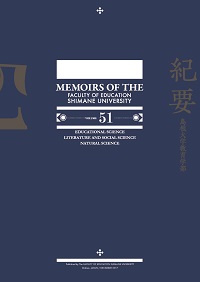島根大学教育学部
ISSN:2433-5355(オンライン)
ISSN:1880-8581(冊子体)
A publication of this bulletin in print format has not been made since no.51.
ISSN:1880-8581(冊子体)
A publication of this bulletin in print format has not been made since no.51.

number of downloads : ?
Use this link to cite this item : https://ir.lib.shimane-u.ac.jp/8132
Memoirs of the Faculty of Education, Shimane University 46
2012-12-25 発行
三郡帯中国地方中部に位置する多里-三坂超マフィック岩体周辺の砕屑性クロムスピネルの化学組成
Chemical Characteristics of Detrital Chromian Spinel in and around Tari-Misaka Ultramafic Complex of the Sangun Zone, Central Chugoku District Southwest Japan
Umeda, Tomoyuki
File
Description
There are many ultramafic complexes some of which have chromitite bodies in the Sangun zone in central Chugoku district, Southwest Japan. Almost all complexes are composed of harzburgite, and sometimes found dunite portion and has small amounts of chromitite in it (e.g. MITI,1993,1994; Matsumoto et al., 1995a). Especially, there are largest chromite mines which are Wakamatsu and Hirose in Northern Tari-Misaka. Exploration for podiform chromitite has been difficult, because its occurrence is usually very irregular in ultramafic complex. Matsumoto and Arai (1997) proposed that the petrological exploration for Podiform chromitite by using of spinel chemistry and morphology. This study is good method for exploration of Podiform chromitite in this area. However, in order for a precision to improve chromite exploration, we should increase the number of sample analysis and accurate quantitative study is required. In this study, we use detrital chromian spinel from river sediment in and around the Tari-Misaka ultramafic complex, Sangun zone, Southwest Japan. That is, it is expected that we can increase analysis point greatly by using detrital spinel from the river sediment than that of from the rock specimen. Many spinel(s) from the chromitite origin were recognized by this study in the river near the chromite mines of northern part of Tari-Misaka complex. This result concordant with chromitite formation model (e.g. Arai and Yurimoto, 1994; Zhou et al., 1994; Matsumoto and Arai, 1997). It became clear in particular that detrital spinel is effective as the method for evaluation of chromitite potentiality in this area.
Other Article
PP. 29 - 41
